Physical Address
304 North Cardinal St.
Dorchester Center, MA 02124
Non-neoplastic disorders of hair comprise mainly the alopecias and hair shaft abnormalities. In this chapter, only the alopecias are considered. Their diagnosis requires close clinicopathologic correlation. The hair shaft abnormalities are covered extensively in various textbooks and atlases, and readers are referred to them.
Alopecias are traditionally classified into nonscarring and scarring (cicatricial) forms. This concept is controversial. In the clinical use of the terminology, a scarring alopecia is synonymous with a permanent one and a nonscarring alopecia with a nonpermanent one. Pathologically, however, a scar represents the endpoint of a reparative fibrosis leading to permanent destruction of preexisting tissue. Not all permanent alopecias, however, are scarring (e.g., morphea of the scalp represents a permanent but not a scarring alopecia). The permanent destruction of the hair follicle in morphea results from a continuous deposition of collagen, which is a nonscarring process. Furthermore, permanent follicular dropout can also be observed in late stage androgenetic alopecia, alopecia areata, or traction alopecia, all of which represent alopecias that are traditionally considered to be nonscarring. Elastic tissue stains such as Verhoeff-Van Gieson highlight the destruction of the elastic fiber network commonly seen in scars and thereby allow for the differentiation of scarring from nonscarring alopecias on histopathologic grounds. Because the terms “scarring” and “nonscarring” are entrenched in the literature, we continue to use them in this chapter, but we caution readers to be fully aware of the ambiguity of this concept.
Alopecias affect certain stages of the hair growth cycle preferentially; the most vulnerable one is the anagen (growth) phase. About 85% of scalp hairs are in the anagen phase, which lasts 2 to 7 years. With a length of about 2 to 3 weeks, the ensuing catagen (involuting) represents the shortest phase of the entire hair growth cycle; it comprises only 1% to 2% of the scalp hair. Roughly 15% of the scalp hairs cycle through the telogen (resting) phase, lasting about 3 months and ending with the shedding of the hair shaft before a new hair growth cycle is initiated.
Traditionally, scalp biopsies are being evaluated in the vertical plane of section. This allows only for the examination of a few hair follicles at a time. Choosing a transverse plane of section overcomes this shortcoming. It is recommended to obtain two 4-mm punch biopsies in the alopecic patient, one for conventional vertical sections and the other one for sectioning in the transverse plane. Half of the vertically cut biopsy can also be used for immunofluorescence.
Large and thick; usually extends into subcutis
Diameter of hair shaft greater than thickness of inner root sheath (>0.06 mm)
Short and thin; bulb usually confined to upper or midreticular dermis
Diameter of hair shaft less than or equal to thickness of inner root sheath (±0.03 mm)
Terminal anagen to vellus hair ratio is 7 : 1
Upper segment: from insertion of pilar muscle to surface
Ostium, infundibulum, isthmus
Lower segment: from insertion of pilar muscle to bulb
Medulla, cortex, and cuticle
| Growth Phases | Percent of Hair in Phase | Duration of Phase |
|---|---|---|
| Anagen (active growth) | (80–90) | 2–7 years |
| Catagen (involution) | (1) | 2–3 weeks |
| Telogen (rest) | (10–15) | 100 days |
Represents involuted portion of the lower segment of the hair
A reservoir of follicular stem cells, residing in the bulge-isthmus area, is central to the hair cycle and initiates a new round of hair growth at the end of the telogen. The slow-cycling stem cells in the bulge induce the anagen by giving rise to transient amplifying cells that represent rapidly dividing cells committed to differentiation. The transient amplifying cells in the fully developed anagen hair follicle are the mitotically active keratinocytes of the hair matrix, which form the hair shaft.
Since the first edition of this textbook, our knowledge on stem cells in alopecias has expanded extensively. The vastly different clinical outcome of scarring versus nonscarring alopecias is popularly explained by the location of the inflammatory infiltrate. Whereas the stem cell–rich follicular bulge is preferentially targeted in lichen planopilaris (LPP), the immunologic attack in alopecia areata centers on the hair bulb. In end-stage LPP, a complete destruction of the bulge results in exhaustion of all stem cells with subsequent irreversible hair loss. In contrast, the inflamed hair bulb in alopecia areata is part of the cycling portion of the pilosebaceous–apocrine unit while the bulge is preserved.
The pathogenetic events occurring in LPP are summarized as the bulge stem cell destruction hypothesis. Other observations of hair follicle biology, however, do not fully lend support to this hypothesis as the sole explanation for the hair loss occurring in scarring alopecias. Recent experiments have shown that fibroblasts from the perifollicular connective tissue sheath transplanted between human subjects are capable of inducing new hair follicles in the absence of any additionally transplanted epithelial component, including bulge keratinocytic stem cells, casting doubt on the exclusive role of the follicular bulge in hair growth initiation.
Another popular hypothesis on the development of scarring alopecias postulates an autoimmune etiology. However, in contrast to alopecia areata, autoantibodies specifically directed against the follicle have not been identified in the blood of LPP patients so far.
Recently, the bulge has been characterized as an immune-privileged anatomic compartment of the hair follicle shielded from harmful inflammatory events by a cascade of immunoinhibitory signals. It is hypothesized that upon collapse of this immune-privileged environment, the bulge becomes accessible to inflammatory destruction. A key molecule on the bulge keratinocytes is CD200, a membranous glycoprotein with immunoinhibitory properties that renders it a “no danger” molecule for the hair follicle. It is thought that its loss ultimately results in scarring alopecia. Intriguingly, cDNA microarray studies found CD200 to be highly upregulated in the bulge keratinocytes of human hair follicles. It was therefore introduced as a new follicular stem cell marker. Thus, scarring in LPP may result from a combination of stem cell destruction and a collapse of the bulge-specific immunologic milieu.
In nonscarring alopecias the overall density of follicles is normal, and folliculosebaceous units are intact as opposed to scarring alopecias, which show a decrease in follicle density and distortion of follicles. Common forms of nonscarring alopecias are discussed in the following text.
Androgenetic alopecia
Senescent baldness
Acute telogen effluvium
Chronic telogen effluvium
Anagen arrest
Alopecia areata
Trichotillomania
Congenital triangular alopecia
Loose anagen hair syndrome
Syphilitic alopecia
The cause of androgenetic alopecia (patterned hair loss or common baldness) is a genetically determined androgen sensitivity of the hair follicle, which varies depending on the region of the scalp. Occipital hair follicles are androgen independent.
The pattern of androgenetic alopecia differs between the sexes. In men, the bitemporal recessus, the frontal as well as the parietal scalp, and the vertex area are involved, but in women, the hair loss is more diffuse, affecting mostly the vertex and the midscalp. Women present most commonly with diffuse hair loss and rarely have complete baldness, as opposed to men, in whom a rim of occipital hair may be the only hair left. Androgenetic alopecia is characteristically gradual in onset with increasing thinning of the hair but can also present with telogen effluvium ( Fig. 8-1 ).
Common disorder
50% of men by age of 50 years
40% of women by age 70 years
Inherited predisposition
Men
Onset of manifestation after puberty
Crown, vertex, frontal, central, and temporal areas of the scalp
Women
Patterned: progressive thinning over frontal and parietal scalp
Retention of frontal hair line
Chronic and progressive
No highly effective treatment
Progression may be slowed by minoxidil
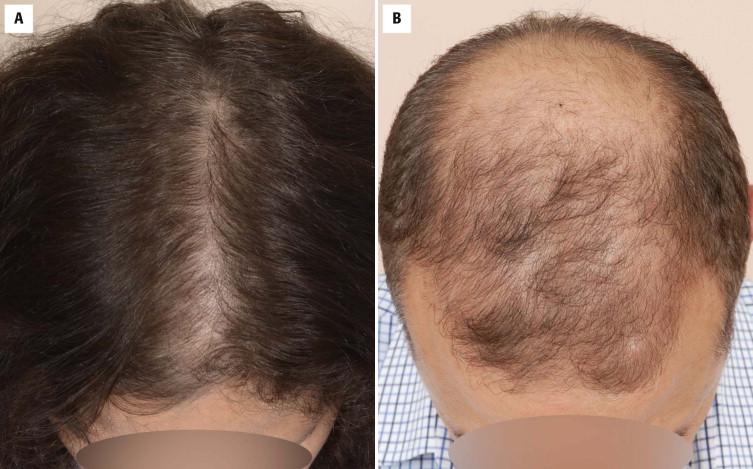
The histopathologic hallmark of androgenetic alopecia is a progressive miniaturization of the terminal hair follicle ( Fig. 8-2 ). The size of the follicle is reduced, as is the hair shaft diameter, but the total number of hairs remains normal. Progressive miniaturization of hair follicles leads to an increased density of vellus hair (see Fig. 8-1 ). In androgenetic alopecia, the terminal : vellus hair ratio is typically 2 : 1 in contrast to a ratio of 7 : 1 in normal scalp. Additionally, an increase of fibrous tracts is seen along the track of the former terminal hair follicles (follicular stelae). Androgenetic alopecia also displays an increase in telogen hairs with a concomitant decrease of those in anagen phase, referred to as a decreased anagen : telogen ratio. The sebaceous glands, especially in men with oily scalp, are enlarged. Although controversial in the past, the presence of an inflammatory infiltrate in androgenetic alopecia is noted in as many as 75% of the patients in the absence of clinical signs of inflammation, mostly around the follicular infundibula but also within the fibrous tracts.
Nonscarring alopecia
Terminal: vellus hair ratio is 2 : 1
Increased number of miniaturized follicles
Lymphocytic infiltrate involving upper third of follicle (variable)
Other nonscarring alopecias, especially telogen effluvium, alopecia areata, and trichotillomania
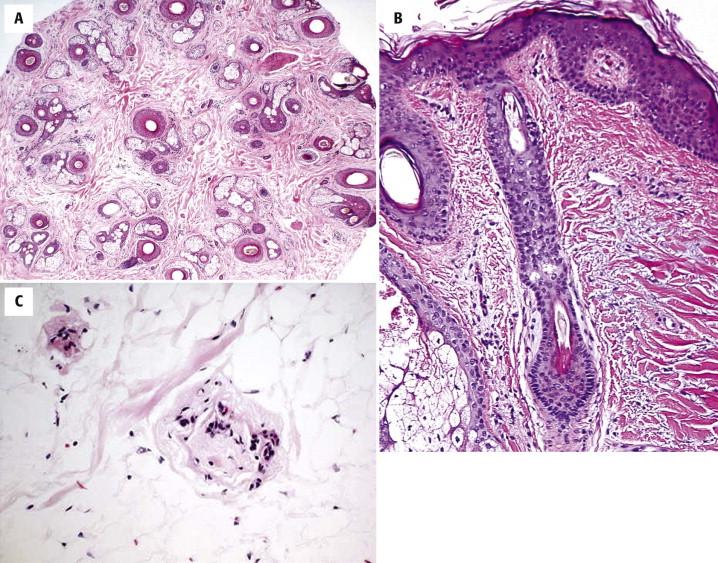
Miniaturization of the hair follicle is not observed in telogen effluvium and trichotillomania. Although it may be seen in longstanding diffuse alopecia areata and alopecia of secondary syphilis, the presence of a peribulbar inflammatory infiltrate in both entities enables their differentiation from androgenetic alopecia. Alopecia areata and trichotillomania reveal an increase of catagen hairs that is not characteristic of androgenetic alopecia.
Androgenetic alopecia in both women and men has responded to topical 2% and 5% minoxidil. The 5% minoxidil has a 40% greater response rate than the 2% when used twice a day for 1 year. Continued therapy is needed to maintain hair growth. The reported response rate is 80% stabilization and 55% mild to marked regrowth. For men with androgenetic alopecia, another option is finasteride 1 mg. One year of finasteride, an α-reductase inhibitor type 2, reveals similar response as with minoxidil. Finasteride is not recommended for reproductive-age women because it is a fetal teratogen. In finasteride studies of postmenopausal women with androgenetic alopecia, therapeutic benefit was not experienced. Other off-label therapies for women include hormonal treatment with oral contraceptives or hormonal replacement therapy combined with antiandrogens such as spironolactone. Finasteride 1 mg/day has been used in women for treatment of androgen excess. In reproductive-age women, it is combined with an oral contraceptive. Cosmetic surgical options include scalp reduction or hair transplants.
Senescent baldness represents the physiologic thinning of hair in both sexes that does not become apparent until after about 50 years of age. It represents a failure of the follicles to regenerate and supports the theory that each follicle has a life cycle ( Fig. 8-3 ).

Patients with senescent baldness but no superimposed androgenetic alopecia have a full head of hair well into middle age. Starting at age 50 years, slow, gradual diffuse thinning of hair sets in without progressing to complete hair loss.
Biopsies are rarely performed for senescent alopecia. Morphologically, a slight decrease in the density of hair follicles with age is noted, often concomitant with a reduction in their diameter. Fibrous tracts are not prominent. Overall, the histopathologic abnormalities are rather subtle, and biopsy is often done for other causes.
In androgenetic alopecia, miniaturization of the hair follicles and often prominent fibrous tracts are characteristic. These changes are accompanied by a greatly reduced terminal : vellus hair ratio. Moreover, the changes are more pronounced on the vertex as opposed to the occipital scalp. All of these features are not characteristic of senescent baldness.
The treatment options for senescent alopecia are as described under androgenetic alopecia.
Telogen effluvium or shedding represents a premature conversion of the anagen hair follicles into telogen with a subsequent hair loss perceived as sudden by the patient. The most common form is the acute form of telogen effluvium, which lasts not more than 6 months, as opposed to the chronic variant. Often acute illnesses, drugs, or giving birth are the inciting events.
Patients experience increased shedding from all over the scalp, usually 2 to 3 months after the inciting event ( Fig. 8-4 ). The shed hairs, commonly around 150 to 200 daily, have the appearance of normal telogen hairs with the typical club-shaped proximal end. The clinical cause is usually self-limited, ending with full recovery.
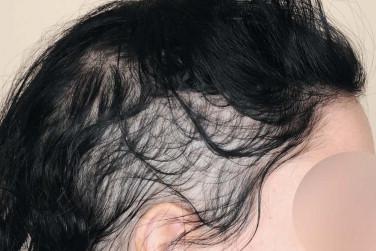
Morphologically, the hair follicles show no abnormalities. The diagnosis of an acute telogen effluvium is mostly a clinical one. In case a biopsy is obtained, the findings depend very much on the timing of it. A normal or even an increased number of anagen hair follicles is noted when the biopsy is taken during the recovery phase and the hair has already cycled back into anagen. An increased number of telogen and catagen hair follicles (a decreased anagen : telogen ratio) is only noted in the early stage of acute telogen effluvium. The total number of hairs is unchanged ( Fig. 8-5 ).
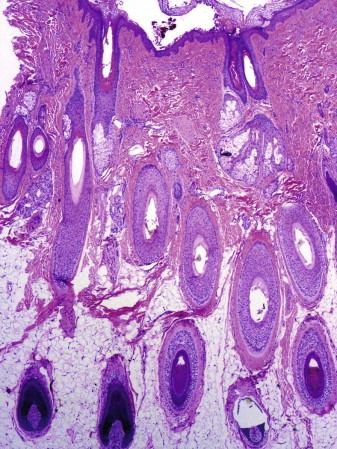
In diffuse alopecia areata, a peribulbar inflammatory infiltrate is present. Androgenetic alopecia is characterized by hair miniaturization. Both androgenetic alopecia and diffuse alopecia areata reveal a relative increase in the number of vellus hair follicles. This is not a feature of acute telogen effluvium. The hallmarks of the recently, mainly clinically, delineated chronic form of telogen effluvium are the female gender preference, the duration of the shedding exceeding 6 months, and the absence of a cause. Histopathologically, the biopsy looks unremarkable.
In acute telogen effluvium, the key to treatment is the identification of the trigger (causative) event, which is responsible for the early conversion of the anagen to the telogen cycle of hair growth (shunt). If the trigger is identified, the treatment is then directed toward the cause. Topical 2% to 5% minoxidil is a helpful therapy irrespective of the trigger.
In anagen arrest, an inciting event, such as chemotherapy, radiation therapy, or an immunologic event, such as observed in the acute onset of alopecia totalis or universalis, induces a sudden stop in the mitotic activity of hair matrix cells.
In contrast to telogen effluvium, hair loss in anagen effluvium is noted shortly after the inciting event, often within 1 to 2 weeks. The resulting alopecia is marked by a loss of more than 80% to 90% of scalp hair. It results from acute breakage of the hair shafts secondary to growth failure. In early anagen arrest, dystrophic hair shafts are shed. They taper down to a point (hence the name pencil-point hairs) and vary in diameter ( Fig. 8-6 ).
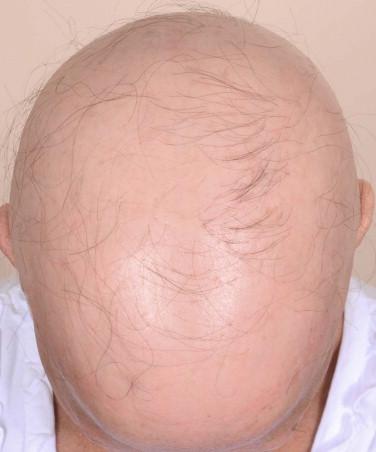
The diagnosis is usually made clinically and by inspection of the shed dystrophic hairs. The few histopathologic reports describe the presence of normal anagen and telogen hair follicles accompanied by minimal inflammation as well as an inversion of the anagen : telogen ratio. Early in the course of anagen arrest, the anagen hair follicles are devoid of entire hair shafts.
The presence of pencil-point hairs should avoid any other differential diagnostic considerations.
Identification of the etiology is essential if one is to determine prognosis and therapy and is directed accordingly.
Patients with alopecia areata often have a positive family history. A genetically determined autoimmune pathogenesis mediated by T lymphocytes is the most likely cause.
The disease commonly affects children and young adults but can present at any age. It presents classically with one or more round or oval, completely bald, smooth patches at any hair-bearing area. “Exclamation-mark” hairs can be pulled from the margin of the patch. Patchy alopecia areata has a high incidence of spontaneous remission. Other clinical variants involve the entire scalp (alopecia totalis) or the entire body hair, including that on the scalp (alopecia universalis) ( Fig. 8-7 ). The least common manifestation is diffuse alopecia areata. It can be clinically mistaken for trichotillomania, telogen effluvium, or androgenetic alopecia.
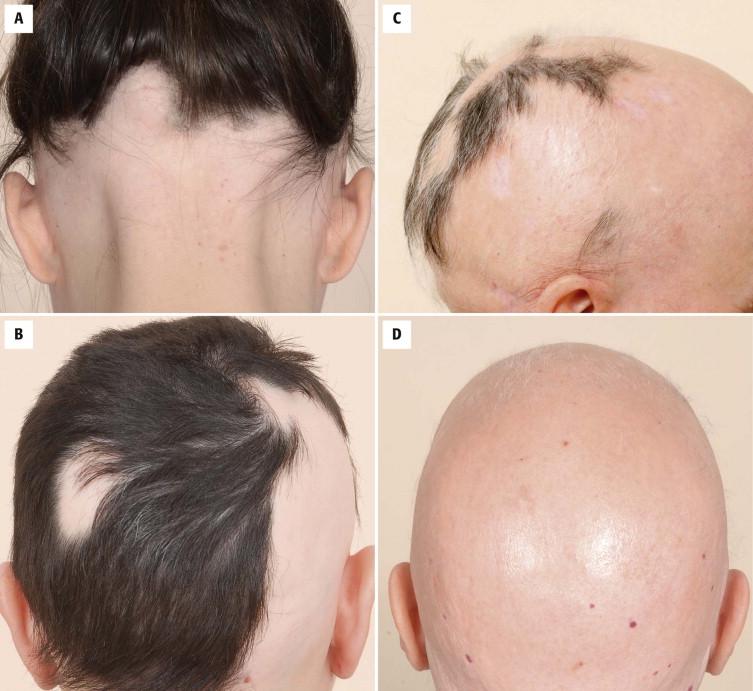
The morphologic hallmark of alopecia areata is a peribulbar and intrabulbar inflammatory infiltrate ( Fig. 8-8 ). It induces the precipitation of catagen and telogen with the subsequent inversion of the anagen : telogen ratio, which is typical of alopecia areata (see Fig. 8-3 ). On scalp biopsy, an increased number of telogen and catagen hairs with accompanying fibrous tracts is noted.
1% to 2% of the U.S. population
May occur at any age
Peak onset between ages 15 and 30 years
Family history of alopecia areata in 20% of patients
20% to 30% have associated other autoimmune disease(s)
Localized type (majority)
Patchy: Well-demarcated round or oval areas of alopecia
Ophiasis: Bandlike pattern along posterior occipital and temporal scalp
Extensive disease (alopecia totalis or universalis)—rare
Often disease onset precipitated by other illness or event
Localized patchy alopecia areata may resolve (hair may regrow)
Extensive disease often persists or worsens with time except for a recently described subtype of “acute diffuse and total alopecia,” which has a more favorable prognosis
Topical immunologic therapy, such as with diphenylcyclopropenone
Steroids or other drugs
Localized patch alopecia areata most likely to respond to treatment
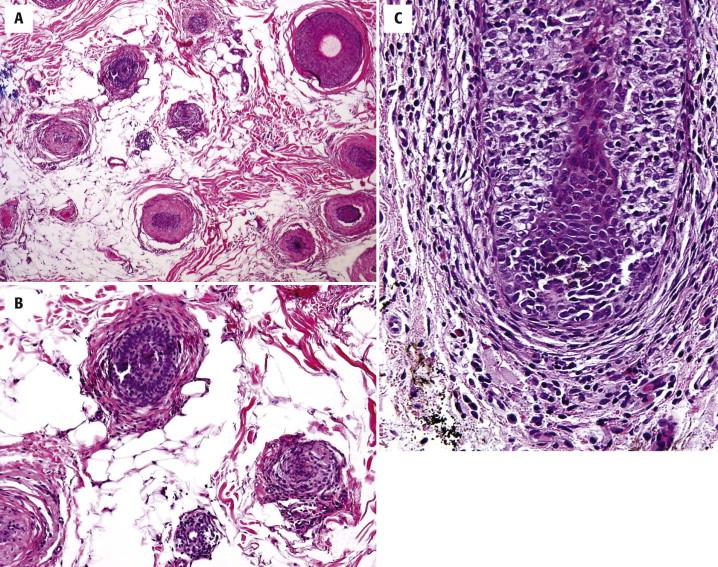
In longstanding alopecia areata, miniaturization of the hair follicles takes place, resulting in an almost complete absence of terminal hairs. The terminal : vellus hair ratio is 1 : 1 in alopecia areata as opposed to 7 : 1 in unaffected scalp. Over time a reduction in the total number of hairs is observed.
The inflammatory infiltrate also affects the bulbar melanocytes, leading to pigment incontinence with deposition of amorphous clumps of melanin in the bulb area and follicular tracts. Distorted hair shafts (trichomalacia) within the follicular canals are also a feature. However, a peribulbar infiltrate is not always present in alopecia areata, depending on the stage of the disease. A helpful diagnostic feature in those cases—especially in the presence of multiple catagen hairs, trichomalacia, and pigment casts (also features of trichotillomania)—is the presence of a small number of eosinophils within the peribulbar infiltrate and follicular tracts. Eosinophils are not a feature of trichotillomania.
The finding of an inflammatory infiltrate around the bulbs of anagen hair follicles greatly facilitates the diagnosis of alopecia areata, and the presence of eosinophils excludes androgenetic alopecia and trichotillomania. Eosinophils, however, are not helpful in differentiating alopecia areata from syphilitic alopecia because they can be found in both entities.
In alopecia areata, the therapeutic modalities differ and depend on the severity. For alopecia areata (patch type, less than 50%), topical high-potency and intralesional corticosteroids (10 mg/cc, 2 to 4 cc every 4 to 6 weeks) are usually successful. In children, topical short- and long-contact intermittent anthralin can be helpful. For more extensive disease, therapies include topical anthralin, topical minoxidil, systemic corticosteroids, cyclosporine, phototherapy, topical sensitization therapies, and combined therapies. The most successful sensitization therapy has been diphencyprone applied several times a week in concentrations ranging from 0.001% to 2% over 1 to 2 years. Reported success rates range from 20% to 60%.
Other treatment modalities have noted very limited success with isoprinosine, thymopentin, nitrogen mustard, azathioprine, and zinc. No therapeutic benefit has been reported with vitamin D analogs, intralesional interferon-α2, and irritants such as croton oil and lauryl sulfate. Acupuncture and aromatherapy have had limited success. The new biologic agents offer some future hope for a more effective therapy. Studies are under way.
Trichotillomania is a self-induced form of traumatic alopecia found in patients with a specific disorder of impulse control.
Become a Clinical Tree membership for Full access and enjoy Unlimited articles
If you are a member. Log in here